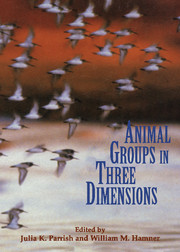Book contents
- Frontmatter
- Contents
- List of contributors
- Acknowledgments
- 1 Introduction – From individuals to aggregations: Unifying properties, global framework, and the holy grails of congregation
- Part one Imaging and measurement
- Part two Analysis
- 7 Quantitative analysis of animal movements in congregations
- 8 Movements of animals in congregations: An Eulerian analysis of bark beetle swarming
- 9 Individual decisions, traffic rules, and emergent pattern in schooling fish
- 10 Aggregate behavior in zooplankton: Phototactic swarming in four developmental stages of Coullana canadensis (Copepoda, Harpacticoida)
- Part three Behavioral ecology and evolution
- Part four Models
- References
- Subject index
- Taxonomic index
8 - Movements of animals in congregations: An Eulerian analysis of bark beetle swarming
from Part two - Analysis
Published online by Cambridge University Press: 01 June 2010
- Frontmatter
- Contents
- List of contributors
- Acknowledgments
- 1 Introduction – From individuals to aggregations: Unifying properties, global framework, and the holy grails of congregation
- Part one Imaging and measurement
- Part two Analysis
- 7 Quantitative analysis of animal movements in congregations
- 8 Movements of animals in congregations: An Eulerian analysis of bark beetle swarming
- 9 Individual decisions, traffic rules, and emergent pattern in schooling fish
- 10 Aggregate behavior in zooplankton: Phototactic swarming in four developmental stages of Coullana canadensis (Copepoda, Harpacticoida)
- Part three Behavioral ecology and evolution
- Part four Models
- References
- Subject index
- Taxonomic index
Summary
Introduction
The mechanisms determining three-dimensional dynamics in animal congregations are behavioral, and thus it is appropriate that the approaches covered in this book are focused primarily on individuals. This chapter breaks out of this mold, because we use a population-level, Eulerian approach (see Ch. 7 by Turchin). A focus on populations, rather than individuals, was forced upon us by the characteristics of our empirical system – the congregation of southern pine beetles around mass-attacked host trees. In fact, in our first (unsuccessful) attempts at quantifying beetle movements in the vicinity of attractive foci, we tried to use an individual-based approach. However, we were not able to consistently follow flying beetles. A certain proportion of beetles flew upwards, out of sight. Even when they remained low, beetles were easily lost against the forest background because they are very small (about 3 mm in length), are dark colored, and fly fast, following erratic paths.
In our second approach, we shifted our focus from the behavior of individuals to the dynamics of groups. Because the Eulerian approach does not keep track of individuals, one cannot directly measure parameters of individual behavior. However, by using behavioral observations and making certain assumptions, we can construct a model of population redistribution, which in turn can be used to interpret population-level data, as well as to make inferences about individual behavior. In this chapter we describe an example of how an Eulerian approach can be usefully employed for measuring certain quantitative features of congregating behavior, in particular, the attractive bias exhibited by flying beetles toward the source of congregation pheromones.
- Type
- Chapter
- Information
- Animal Groups in Three DimensionsHow Species Aggregate, pp. 113 - 125Publisher: Cambridge University PressPrint publication year: 1997
- 4
- Cited by



